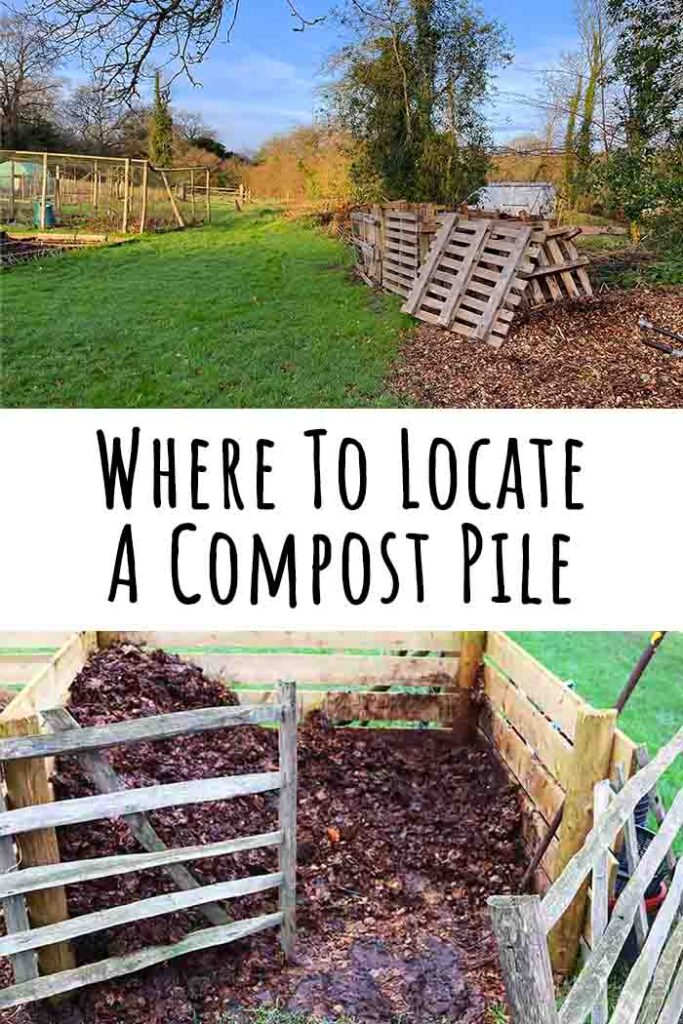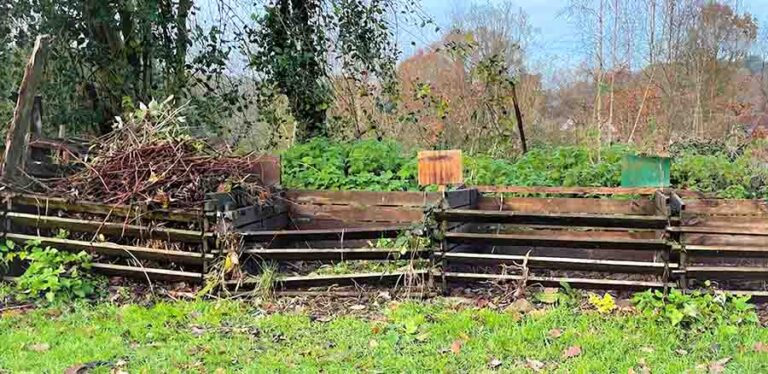Where To Locate A Compost Pile

Deciding where to locate a compost pile is an important business. It’s tempting to put your compost pile in an unloved, unused, out-of-sight part of the yard. But you’re probably going to achieve better results if you place it somewhere accessible, convenient, and where the conditions are favorable for making compost. Let’s take a look at what makes a good spot for composting in. And whether you should be even be moving your compost pile around!
- Working within the limitations of your space
- Drainage
- Soil vs hard standing
- Is sun or shade better?
- Keep it convenient!
- Keep it in one place, or move it around?

Working within the limitations of your space
This article is about where we’d all be constructing our compost heaps in an ideal world. But obviously in the real world, our options are likely to be limited in one way or another by our space. My own back yard doesn’t have anywhere suitable for an open compost bay, so I have a worm farm instead. In the community garden where I have a plot for growing produce, the plots are small and arranged in a grid on an open site. So it’s hard to do anything more adventurous than simply position your composter in a corner of the plot. Like this:

At the end of the day though, any attempts to recycle our kitchen and garden waste into compost is worthwhile. Not only is the compost good for our plants, the very act of recycling our waste for ourselves is full of benefits. And most shortcomings in our environment can be overcome. So let’s look at the ideal location for a compost pile, including how to work around any drawbacks of your site.
Drainage
Compost piles do best if they are well drained. If your compost pile is knee deep in water during wet weather, the friendly bacteria responsible for most of the decomposition inside it will drown. Some strategies for achieving good drainage include:
- If your yard is sloped, construct your compost bays in a high position.
- Line the bottom of your bay with small branches, sticks and twigs.
- You can even put an old pallet in the bottom of your compost bay to lift the base of your pile off the ground.
- If insufficient drainage is a persistent problem, try covering the top of the pile in wet weather. Or keep it covered all year round, and take charge of maintaining optimal moisture by watering it with a hose periodically.
Things to remember:
- Your yard is part of a wider landscape. These communal compost piles in our community garden sit at the bottom of a sloping site. But the ground slopes away further still beyond the boundary of the site, to a pond. So they drain just fine.

- Drainage through your compost heap is just as important as drainage from the base. Maintain an open structure as you fill it by including lots of bulky brown materials like straw, dry leaves, and chopped or shredded woody material.

Soil vs hard standing
Putting a compost pile on concrete or paving is generally not a good idea. It really ought to be placed directly onto the earth or soil. This allows access to your composting material by the microbes that will break it down. And it lets your pile drain freely into the ground.
If you do have to place a compost bin onto a hard surface:
- Line the base with a thick layer of newspaper or corrugated cardboard to soak up excess liquid.
- Cover it in wet weather to prevent the contents getting too wet.
- Accept that the slabs or concrete underneath are probably going to get permanently stained.
Is sun or shade better?
Traditional wisdom dictates that placing your compost pile in a sunny spot is better. Warmth from the sun will help heat up a hot compost pile, creating favorable conditions for thermophilic decomposing bacteria, and speed up the composting process.
Despite this, lots of gardeners deliberately locate their compost piles in a shady corner, or in the shadow of a tall fence or hedge. The reasoning for this is that decomposition will happen regardless. Maybe a little slower, but provided the right balance of green and brown materials are added, and the friendly bacteria have access to moisture and oxygen, nothing is going to stop them! So if you have a shady spot, it makes more sense to have a compost pile there than to struggle growing plants there.
Similarly, if you have a spot under some trees or by a hedge, where plants don’t grow well because the tree or hedge is already taking most of the moisture out of the soil, then it’s a great spot for a compost pile.

Keep it convenient
It’s an essential fact of human nature that we’re not much good at maintaining good recycling habits unless it’s really, really easy. The less effort it requires, the more likely we are to succeed. So if you’re lucky enough to have a big yard, don’t locate your compost pile at the furthest point from the kitchen door. The further away it is, the less motivated you’ll be to take your kitchen waste caddy out to it. Keep it somewhere you can get to easily, and think about the route you’ll take there too. If you have to cut across your lawn to reach it, eventually you will make a permanent track in the grass. And if there’s a path, make sure it’s not too slippery in winter.
Keep it in one place, or move it around?
If you place your compost pile on bare earth, then some nutrients from every batch of compost you make are going to leach into the soil below. And while your cured compost sits waiting to be used, busy earthworms will start dragging it down into the ground, further improving the fertility of the soil. Not to mention the structure and water-retention! Within a year or so, it’s going to be probably the best soil in your yard. If you have space to relocate your compost pile, you can use the rich soil that was underneath it for growing greedy produce or flowers, like zucchini, pumpkins, or sweet peas.

Where to locate a compost pile – summary
An ideal location for a compost heap is a sunny spot on bare soil, with good drainage, and convenient to reach from the kitchen. But you can still make great compost in the shade and on hard standing. If you don’t have anywhere suitable to start a compost pile, you can make compost in a container instead. Or you can set up a worm farm like me! The benefits of recycling your kitchen and garden waste extend beyond simply producing compost for your plants, so what really matters is finding something that works for you!
Let us know where you’re planning to set up your compost pile in the comments box down below. Are your feeling confident about your chosen location?






